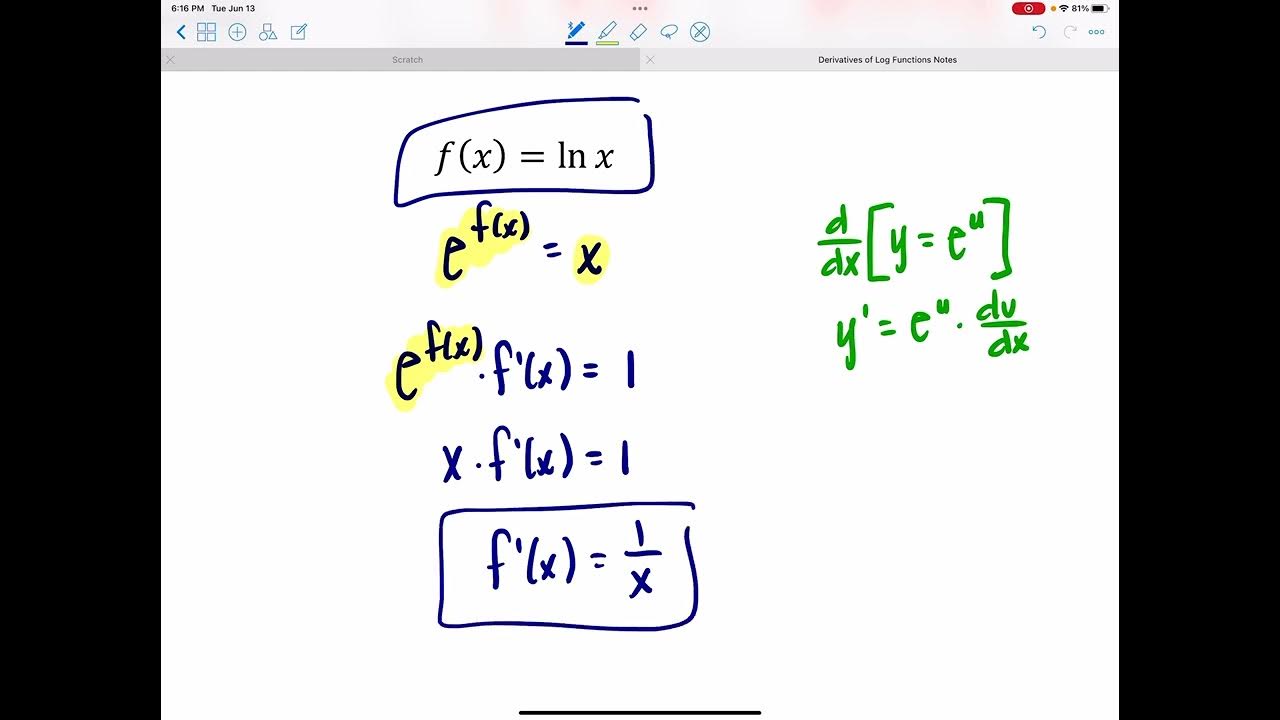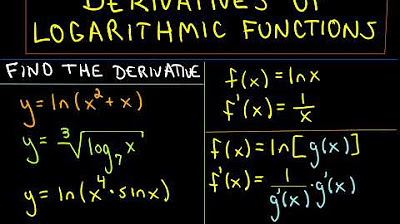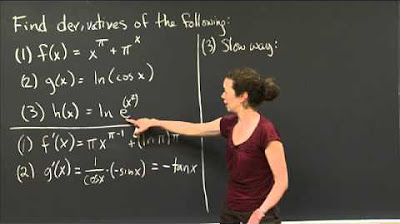Derivatives of Logarithmic and Exponential Functions
TLDRIn this calculus video, Professor Dave derives rules for differentiating logarithmic and exponential functions. He starts with basic logarithm rules like the derivative of the natural log of x being 1/x. Using the chain rule, more complex derivatives are taken, like ln(sin(x)) = cot(x). For exponents like 2^x, the derivative rule is to bring down the natural log of the base times the original function. Towards the end, Dave shows a series representation of e^x and takes the derivative term-by-term to elegantly prove the function equals its own derivative.
Takeaways
- 😀 We can use rules to find derivatives of logs and exponentials without derivations
- 👍 The derivative of ln(x) is 1/x and log base a of x is 1/(ln(a) * x)
- ✏️ Use chain rule when differentiating composite functions with logs, like ln(sin(x))
- 📉 Derivative of a^x is ln(a)*a^x; if the exponent has x, multiply by its derivative
- ☝️ Special case: Derivative of e^x is just e^x itself
- 🤓 We can prove this using the factorial representation of e^x
- 💡 Taking derivative turns the series back into itself
- 🎯 So e^x equals its own derivative, meaning slope = function at every point
- 🔍 This will be key when we learn integration
- 🧠 Let's apply these rules to differentiate logs and exponentials
Q & A
What is the derivative of the natural log of x?
-The derivative of the natural log of x is equal to 1/x.
How do you find the derivative of a logarithm with some base a?
-Use the change of base formula to express it in terms of the natural log, then take the derivative. The final result will be 1/(ln(a) * x).
What is the process for differentiating a composite function involving logs, like ln(sin(x))?
-Use the chain rule - take the derivative of the outer function (ln(x)) and multiply by the derivative of the inner function (cos(x)). This gives cotangent(x).
What is the derivative of e raised to the x power?
-Remarkably, the derivative of e raised to the x power is itself. This can be proven using the factorial representation of e.
How do you differentiate an exponential function with a variable exponent?
-Take the natural log of the base times the original function, then multiply by the derivative of the exponent.
What is the derivative rule for a general exponential A^x?
-The derivative is equal to the natural log of A times A^x.
How can you differentiate log base 10 of x squared?
-Use the chain rule - take the derivative of the outer function (1/(ln(10)*x^2)) and multiply by the derivative of the inner function (2x).
Why is the derivative of e^x equal to itself?
-Graphically, this means every point on the curve is equal to the slope at that point. So the function is its own derivative.
What is an example of an exponential function?
-An exponential function has the variable in the exponent, rather than a power - for example 2^x.
What is the overall process for differentiating logs and exponentials?
-Apply derivative rules like the power rule and chain rule as necessary. Memorize rules for ln(x) and general exponential/log functions.
Outlines
📝 Key differentiation rules and examples
Paragraph 1 discusses several key rules for differentiating various functions like polynomials, logarithms, exponentials, etc. It provides specifics like the derivative of natural log x being 1/x, log base a of x being 1/(ln a * x), exponential function of A^x being ln A * A^x. It shows examples of applying these rules through chain rule to find derivatives of functions like ln(sin x), log10(x^2), 2^(3x+1), etc.
🔢 Proof: derivative of e^x is e^x
Paragraph 2 shows a proof that the derivative of e^x is e^x itself using the factorial representation of e. It takes the derivative of each term in the series expansion of e^x and shows the series remains unchanged, thus proving the derivative result. It notes how this makes e^x equal to its own slope at every point.
Mindmap
Keywords
💡derivative
💡chain rule
💡logarithm
💡exponential function
💡e
💡factorial
💡natural logarithm
💡power rule
💡calculus
💡cotangent
Highlights
The derivative of the natural log of x is equal to one over x
The derivative of any logarithm of x with some other base is one over (the natural log of that base times x)
The derivative of the natural log of a function g(x) is g'(x) over g(x)
The derivative of an exponential function A^x is equal to the natural log of A times A^x
The derivative of e^x is just e^x
A series representation of e^x can be differentiated term by term to show the derivative of e^x is itself
If a function equals its own derivative, every point on the function equals its slope at that point
The derivative of the natural log of sine x is cotangent x, by applying the chain rule
Exponential functions have the variable in the exponent, unlike polynomial functions
If the exponent of an exponential function has x, multiply the derivative by the derivative of the exponent
Log and exponential derivative rules extend differentiation to more function types
The chain rule is key for differentiating composite functions with logs and exponents
Memorizing key derivative rules saves work differentiating logs and exponents later
Derivatives of exponentials require distinguishing cases based on if x is the lone exponent
Understanding why e^x equals its own derivative leads to deeper insight about integration
Transcripts
Browse More Related Video
5.0 / 5 (0 votes)
Thanks for rating:





